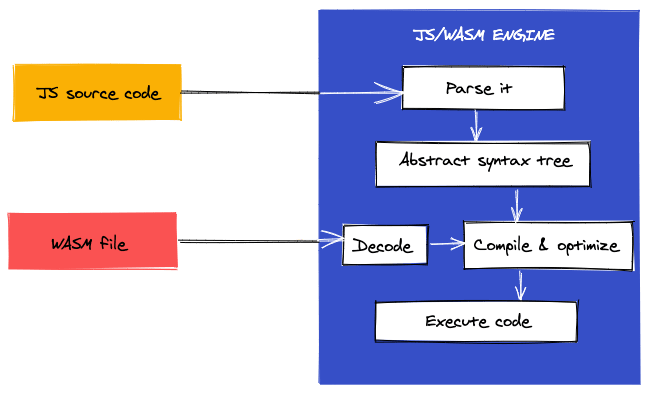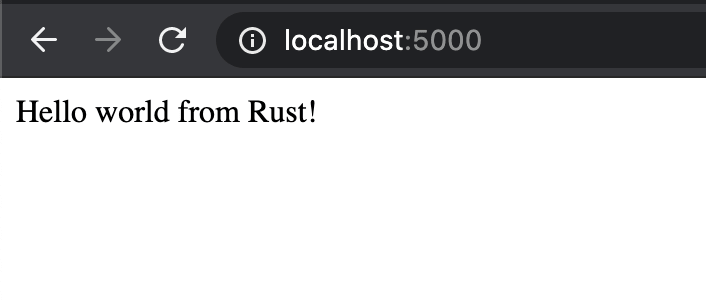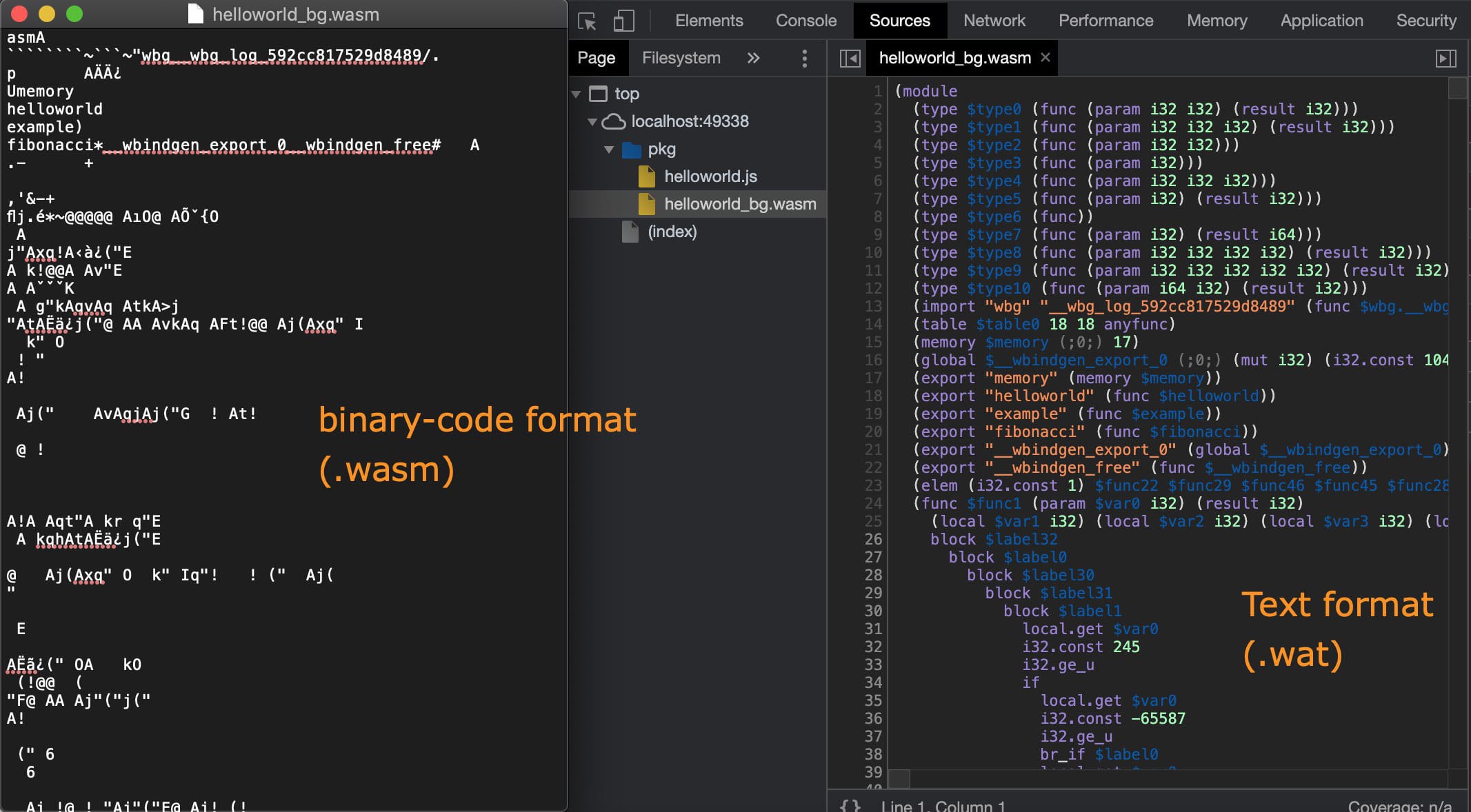We'll see how to run native code in the browser, doing faster web applications, being able to reuse old code like retro videogames, and at the same time learning the future of web development.
We'll cover the following:
- What is WebAssembly?
- Why in Rust?
- Execute Rust code from JavaScript
- Execute JavaScript code from Rust
- Performance - JavaScript vs Rust
- Debugging
- Publishing to NPM
- Code from the article
- Conclusions
- References
What is WebAssembly?
In all current browsers, there is a JavaScript engine that interprets and executes the code. This has allowed us to implement very rich web applications because JavaScript is getting better and more complete every day. However, it's a high-level language but still not ideal for some tasks because it has not been developed to be a fast language with a lot of performance.
WebAssembly (WASM) is a new portable binary-code format that can be executed in modern browsers. It is complemented with a text format (WAT) to make it more readable/debuggable for us, in addition, to allow us to code directly in a kind of "assembly" code. It's an open W3C standard still in progress that allows us to write fast and efficient code for the web in other languages than JavaScript and it runs with a similar performance to the native language. It's not here to replace JavaScript, but to complement it.

Another purpose of WebAssembly is to keep the web secure, light and fast, keeping a small .wasm file size and always maintaining backwards-compatibility in new WASM features, so the web doesn't break.
There are more than 40 supported languages for WebAssembly, the most common are C, C++, and Rust for their performance and maturity, although you also can write code for WASM with high-level languages like Python, PHP or even JavaScript!
Some practical uses of WebAssembly:
- Encryption
- Games that require a lot of assets
- Image and video editing
- P2P
- High-performance algorithms
- VR, AR
- Visualizations and simulations
- A big etc...

Why in Rust?
Perhaps you wonder why choose Rust, when we have so many languages available with WebAssembly. There are several reasons for that:
- Performance: Rust is free from the non-deterministic garbage collection and it gives to programmers the control over indirection, monomorphization, and memory layout.
- Small
.wasmsizes: Rust lacks a runtime, enabling small.wasmsize because there is no extra bloat included like a garbage collector. Hence you only pay in code size, for these functions that you're using. - Integration: Rust and Webassembly integrates with existing JavaScript tooling (npm, Webpack...).

Execute Rust code from JavaScript
Assuming you have both NPM (for JS) and Cargo (for Rust), another prerequisite we need to install it is wasm-pack:
> cargo install wasm-pack
Rust code
Let's create a new Rust project for the "Hello world":
> cargo new helloworld --lib
On Cargo.toml we are going to add the next:
[package]
name = "helloworld"
version = "0.1.0"
authors = ["Aral Roca Gomez <contact@aralroca.com>"]
edition = "2018"
## new things...
[lib]
crate-type = ["cdylib"]
[dependencies]
wasm-bindgen = "0.2.67"
[package.metadata.wasm-pack.profile.release]
wasm-opt = ["-Oz", "--enable-mutable-globals"]
cdyliblib forwasmfinal artifacts.- wasm-bindgen dependency to facilitate high-level interactions between Wasm modules and JavaScript.
Note: The latest part about
--enable-mutable-globalsin principle, in upcomingwasm-bindgenreleases, should not be needed but for this tutorial it's necessary. Otherwise we can not work with Strings.
WebAssembly only supports the i32, u32, i64, and u64 types. If you want to work with other types, such as String or Objects, you normally must first encode them. However, wasm-bindgen does these bindings for us. There's no need to worry about it anymore. That said, let's create our helloworld function to return a String in src/lib.rs:
use wasm_bindgen::prelude::*;
#[wasm_bindgen]
pub fn helloworld() -> String {
String::from("Hello world from Rust!")
}
Compilation
Let's compile Rust's code with:
> wasm-pack build --target web
We are using the web target, however, there are different targets we can use depending on how we want to use that wasm file:
- --target bundler - for bundlers like Webpack, Parcel, or Rollup.
- --target web - for the web as ECMAScript module.
- --target no-modules - for the web without ECMAScript module.
- --target nodejs - for Node.js
After executing the above command, a pkg directory will have been created with our JavaScript library containing the code we have made in Rust! It even generates the "types" files of TypeScript.
> ls -l pkg
total 72
-rw-r--r-- 1 aralroca staff 929 Aug 15 13:38 helloworld.d.ts
-rw-r--r-- 1 aralroca staff 3210 Aug 15 13:38 helloworld.js
-rw-r--r-- 1 aralroca staff 313 Aug 15 13:38 helloworld.wasm
-rw-r--r-- 1 aralroca staff 268 Aug 15 13:38 helloworld_bg.d.ts
-rw-r--r-- 1 aralroca staff 15160 Aug 15 13:38 helloworld_bg.wasm
-rw-r--r-- 1 aralroca staff 289 Aug 15 13:38 package.json
Now it's ready as a JavaScript package so we can use it in our project or even upload the package to NPM as we can see later.
The .js file contains the necessary "glue" code to not have to worry about working outside the pkg with buffers, text decoders, etc.
Use the compiled code on our JS project
In order to use the wasm file in our JavaScript, we can import the generated pkg module to our project. To test it, we can create an index.html on the root of the Rust project with this:
<!DOCTYPE html>
<html>
<head>
<meta charset="UTF-8" />
<title>"Hello world" in Rust + Webassembly</title>
<script type="module">
import init, { helloworld } from './pkg/helloworld.js'
async function run() {
await init()
document.body.textContent = helloworld()
}
run()
</script>
</head>
<body></body>
</html>
As you can see, before using the helloworld function it's important to call the asynchronous init function in order to load the wasm file. Then, we can use the public Rust functions more easily!
To test it, you can do npx serve . and open http://localhost:5000.

Execute JavaScript code from Rust
It is possible to use JavaScript code within Rust, for example, to use window variables, write in the DOM or call internal functions such as console.log. All we have to do is to declare the JavaScript bindings we want to use inside extern "C".
As an example we are going to use the function console.log inside Rust:
use wasm_bindgen::prelude::*;
#[wasm_bindgen]
extern "C" {
#[wasm_bindgen(js_namespace = console)]
fn log(s: &str);
}
#[wasm_bindgen]
pub fn example() {
log("Log from rust");
}
As we can see, inside the extern "C" we have to indicate the js_namespace (console) declaring the function that we'll use inside the namespace (log). In this case, we've put only one string as a parameter but if we wanted to execute a console.log with multiple parameters they would have to be declared.
And in our JS:
import init, { example } from './pkg/helloworld.js'
async function run() {
await init()
example() // This will log "Log from rust" to the console
}
run()
Performance - JavaScript vs Rust
Let's do a comparison of a slightly more expensive function, such as the fibonacci function, to see how it performs in both Rust and JavaScript:
use wasm_bindgen::prelude::*;
#[wasm_bindgen]
pub fn fibonacci(n: u32) -> u32 {
match n {
0 | 1 => n,
_ => fibonacci(n - 1) + fibonacci(n - 2),
}
}
Using the console.time function we can measure the performance of each one:
import init, { fibonacci } from './pkg/helloworld.js'
function fibonacciInJs(n) {
if (n <= 1) return n
return fibonacciInJs(n - 1) + fibonacciInJs(n - 2)
}
async function run() {
await init()
const num = 20
console.time('Fibonnaci in rust')
const fibRust = fibonacci(num)
console.timeEnd('Fibonnaci in rust')
console.time('Fibonnaci in JS')
const fibJS = fibonacciInJs(num)
console.timeEnd('Fibonnaci in JS')
document.body.textContent = `Fib ${num}: Rust ${fibRust} - JS ${fibJS}`
}
run()
And the result:

- In Rust: 0.13ms
- In JS: 1.28ms
Around x10 times faster in Rust than in JS!
However, it's important to note that not all functions we implement in Rust will be faster than in JavaScript. But there will be a considerable improvement in many of them that require recursion or loops.
Debugging
If in devtools -> source we look inside our files for our .wasm file, we'll see that instead of binary it shows us the WAT file being more readable and debuggable.

For a better debugging experience, you can use the --debug flag to display the names of the functions you have used in Rust.
> wasm-pack build --target web --debug
For now, with wasm-bindgen it's not possible to use source-maps to display the code in Rust on devtools. But I suppose in the future it will be available.
Publishing to NPM
Once we have our pkg directory generated, we can package it with:
> wasm-pack pack myproject/pkg
And publish it at npm with:
> wasm-pack publish
They work the same way as with npm pack and npm publish, so we could use the same flags as wasm-pack publish --tag next.
Code from the article
I've uploaded the code used in this article to my GitHub:
Conclusions
In this article, we've seen a bit of what WebAssembly is and what is necessary to start creating web applications with Rust.
We have used Rust because is one of the best integrated but it's possible to use many other languages. This way, we can bring back to life old applications made with languages like C or C++, and implement more futuristic and portable applications for VR or AR. All this thanks to the browser!




